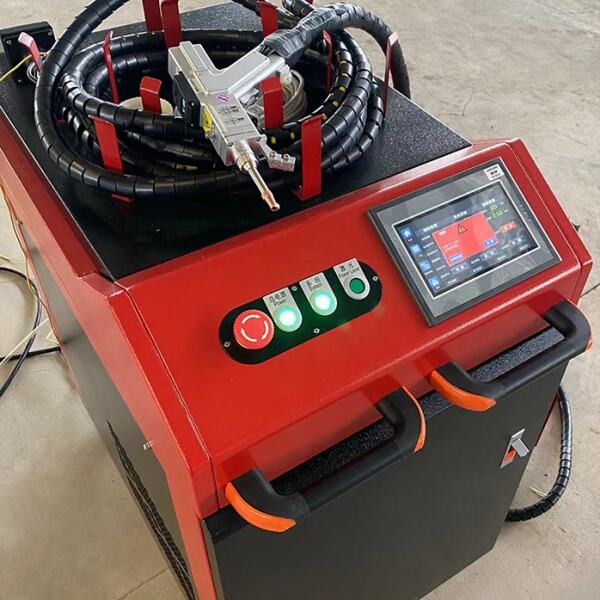Understanding High-Power Laser Sources in Laser Welding Machines
High-power laser sources form the operational backbone of modern laser welding machines, enabling unprecedented precision and scalability in industrial applications. These systems rely on advanced photonics to deliver concentrated energy outputs ranging from 1 kW to over 20 kW, redefining speed and quality standards across manufacturing sectors.
What Defines a High-Power Laser Source?
When talking about high power lasers, there are basically three main factors that define their performance: how much power they put out, the quality of their beam, and how efficiently they convert energy. Lasers that can push past the 1 kW mark tend to create much deeper welds, sometimes going all the way through 25 mm thick steel plates. The wavelength matters too, with fiber lasers operating around 1 micrometer and CO2 models working at about 10.6 micrometers, which makes them suitable for different materials. For those really fine details work, the beam parameter product becomes important. Values under 2 mm·mrad mean the laser can be focused down to very small spots, allowing for extremely precise cuts and welds at the micron level that many industrial applications require.
The Role of Laser Source and Generation in Modern Welding Systems
Laser generation technology directly impacts weld integrity and production throughput. Fiber lasers achieve >30% wall-plug efficiency, reducing energy costs by up to 50% compared to traditional CO2 systems. Pulsed laser configurations allow adjustable peak powers (0.1–5 kW) and frequencies (10–5000 Hz), enabling seamless transitions between thin foil welding and heavy-section joining.
Types of Lasers Used in Industrial Laser Welding Machines
- Fiber Lasers: Dominating 68% of industrial installations (2023 industry data), these excel in reflective metal processing with 1070 nm wavelengths.
- CO2 Lasers: Maintain relevance for >6 mm non-ferrous metals through 10.6 μm wavelength absorption.
- Solid-State Lasers: Nd:YAG variants offer multi-kilowatt outputs for hybrid welding applications requiring precise thermal control.
This technological diversity allows manufacturers to optimize weld quality while meeting strict automotive, aerospace, and medical industry specifications.
Fiber Lasers vs. CO2 and Solid-State Lasers: Technology Comparison and Performance
How Fiber Lasers Enhance Efficiency in Laser Welding Machines
Fiber lasers are actually about 30 to 50 percent more efficient when it comes to energy consumption compared to traditional CO2 models. This is because they channel light through these special doped fiber optics which cuts down on power waste quite a bit. The solid state construction means no more dealing with those pesky gas refills or constantly adjusting mirrors, something that can save shops around 70% on maintenance expenses over time. When working with materials like stainless steel, these lasers can cut through metal at speeds faster than 20 meters per minute without losing beam stability. That kind of performance makes them really attractive for manufacturers running fast paced operations such as automotive production facilities where speed matters most.
Advantages of Fiber Lasers Over Traditional CO2 Lasers
Carbon dioxide lasers work around the 10.6 micrometer wavelength range, something that doesn't get absorbed well by shiny metals such as copper or aluminum. Fiber lasers tell a different story though they put out light at about 1.06 micrometers instead. This means metals soak up about five times more energy from them, so processing happens quicker and welds tend to hold together better without issues. What makes fiber lasers even more appealing for factories is their lack of need for regular refills of expensive gases. Instead they rely on solid state components that rarely need attention, which translates into roughly ninety percent less time spent waiting for machines to be back online after maintenance stops production cold.
Performance Comparison: CO2 and Solid-State Lasers in High-Power Applications
CO2 lasers work pretty well on non-metal materials such as various polymers, often producing kerf widths below 0.1 mm which is quite impressive. For medical applications though, solid state Nd:YAG lasers tend to be better because they deliver pulsed energy that's gentler on sensitive components during device welding processes. When it comes to handling multiple materials at once though, fiber lasers really stand out from the competition. These systems combine power outputs exceeding 4 kW with smart cooling mechanisms that help avoid unwanted heat damage, especially important when working with high strength aerospace grade titanium alloys where precision matters most.
Market Trends: Rising Dominance of Fiber Lasers in Industrial Manufacturing
Fiber lasers now represent 68% of global industrial laser sales (Laser Systems Europe 2024), driven by their compatibility with Industry 4.0 workflows. Automotive manufacturers report 40% faster cycle times when integrating fiber lasers with robotic welding cells, while aerospace suppliers leverage their precision for crack-free turbine blade repairs.
Key Industrial Applications of Laser Welding Machines
Aerospace: Meeting Precision and Reliability Standards
In the world of aerospace manufacturing, high power laser welding machines stand out because they deliver those crucial micron level accuracies needed for quality work. These machines can weld parts like turbine blades and fuel system housing components without messing with the heat resistant qualities of materials such as nickel alloys and titanium. Recent research from 2023 conducted by a team of aerospace engineers showed something interesting too. When they looked at new generation aircraft fuselages made using laser welding techniques, these structures ended up being about 18 percent lighter overall compared to traditional methods, all while still passing the strict FAA requirements for fatigue resistance testing.
Automotive Manufacturing: Lightweight, Durable Joints at Scale
Car companies are turning to laser welding as they try to build lighter electric vehicles while keeping up with mass production needs. This technique works really well for joining different materials such as aluminum alongside those fancy new steel alloys, which helps make parts for batteries and vehicle structures both thinner and tougher than before. Some big name car makers have seen around a third less thermal distortion when using lasers instead of traditional welding techniques, which means their assembly lines can move faster without compromising quality standards across the board.
Medical Device Production: Ensuring Sterility and Micron-Level Accuracy
Laser welding plays a big role in medical manufacturing where it creates those crucial hermetic seals needed for things like pacemakers and various surgical instruments. And this is all done following strict ISO 13485 standards for keeping everything sterile. What makes this technique so valuable is that it doesn't involve physical contact during the process, which means there's no risk of contaminating sensitive materials. The welds themselves can be incredibly tiny too, sometimes under 50 microns wide. That level of detail matters a lot when making stuff like coronary stents or parts for insulin pumps where space is at a premium. We've seen some pretty cool developments lately too. Manufacturers can now work with certain biocompatible plastics using precision down to 0.1 mm, opening up new possibilities for creating smaller, less intrusive surgical tools that doctors really need these days.
General Industrial Use: Integration in High-Volume Production Lines
Laser welding systems work pretty well across all sorts of industries these days, whether it's tiny gadgets we carry around or massive machines used on farms and construction sites. The programmable optics actually mesh really well with robotic arms too, running nonstop in places where they fix everything from computer chips down to big metal parts for tractors and harvesters. Some recent studies from last year showed something interesting happening in factories everywhere - companies were spending about 27 percent less money fixing up welds after production because lasers just do such an accurate job over and over again. That kind of consistency saves both time and cash when making products at scale.
Core Advantages of High-Power Laser Welding Systems in Modern Manufacturing
High-power laser welding machines revolutionize industrial production by delivering four strategic benefits—precision, thermal control, cost efficiency, and smart factory integration.
Unmatched Precision: Achieving Micron-Level Weld Accuracy
Modern systems produce weld seams as narrow as 0.1 mm, supporting complex geometries in medical implants and microelectronics. A 2025 materials study showed laser welding reduces aerospace component rejection rates by 58% compared to plasma arc methods through consistent penetration depth control within ±0.05 mm.
Controlled Heat Input for Minimal Distortion and High Integrity
The concentrated beam limits heat dispersion to 0.8–1.5 mm around weld zones, versus 3–5 mm in TIG welding. This prevents warping in automotive battery trays while maintaining tensile strength above 500 MPa—critical for EV safety components requiring less than 0.2% post-weld deformation.
Energy Efficiency and Long-Term Cost Savings with Advanced Laser Sources
Fiber lasers convert 38% of input energy into beam power, significantly outperforming CO2 lasers, which achieve only 12% efficiency. This translates to annual power savings of 740 kW per machine. Manufacturers welding stainless steel at 45 meters per minute report 22% lower production costs (Industrial Energy Report 2025).
Seamless Automation and Scalability in Smart Factory Environments
Integrated vision systems enable real-time seam tracking with 0.02 mm positional accuracy. One Tier 1 auto supplier achieved 93% first-pass yield using AI-powered laser cells that automatically adjust 14 welding parameters, reducing rework costs by $1.2 million annually (Smart Manufacturing Journal 2025).
FAQs
What is a high-power laser source in welding machines?
A high-power laser source refers to a laser device that provides energy outputs ranging from 1 kW to over 20 kW, allowing for precise and scalable welding processes in industrial applications.
How does laser generation technology affect welding?
Laser generation technology impacts weld integrity and production throughput. It enables energy efficiency, variable energy outputs, and seamless transitions between different welding requirements.
Why are fiber lasers preferred over CO2 lasers?
Fiber lasers are more energy-efficient and require less maintenance compared to CO2 lasers. They work well with a broader range of materials, making them more versatile for industrial applications.
What industries benefit from high-power laser welding machines?
High-power laser welding machines are beneficial in industries such as aerospace, automotive manufacturing, medical device production, and general industrial applications.



